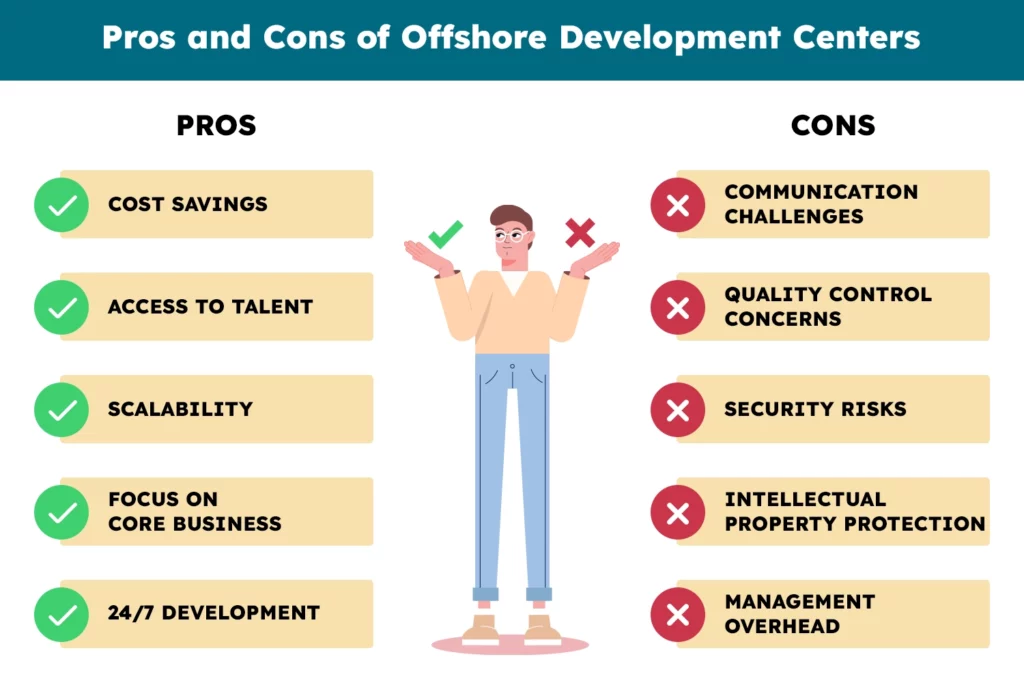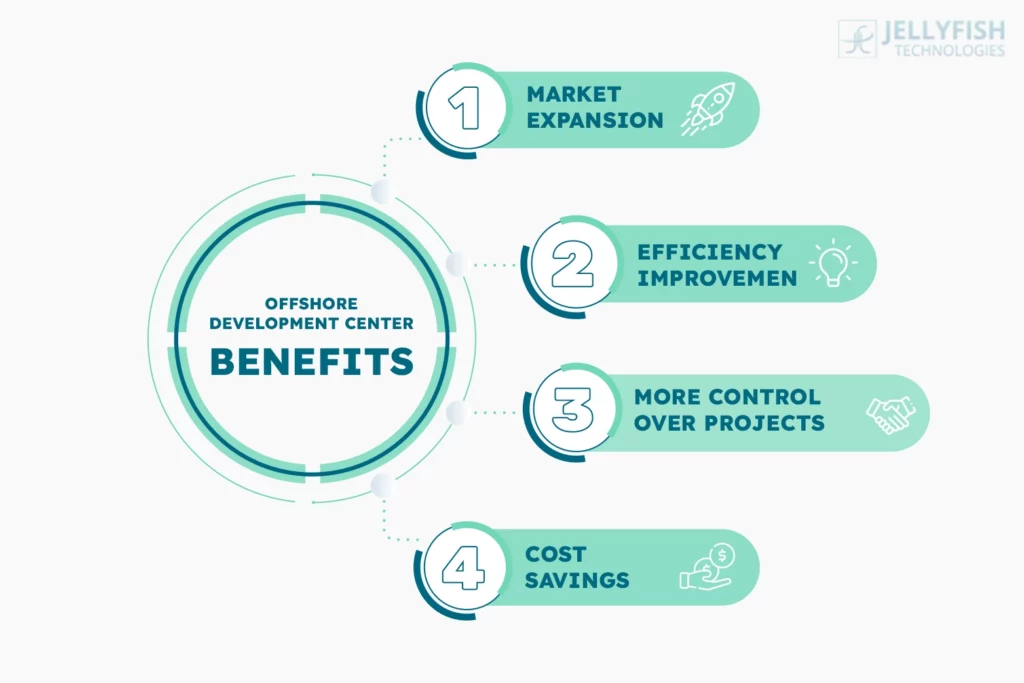In today’s hyper-competitive technological landscape, businesses are constantly seeking ways to optimize resources and gain an edge. One increasingly popular strategy is establishing an Offshore Development Center (ODC). But what exactly is an ODC, and how can it benefit businesses and tech endeavors?
In this blog, we’ll unravel the world of ODCs, with a special focus on Offshore Development Centers in India. Exploring their various models, potential advantages and disadvantages, and essential best practices for ensuring success.
What is an Offshore Development Center (ODC)?
An ODC is a dedicated unit established by a company in a foreign country to manage software development offshore companies or IT services remotely. Think of it as an extension of your in-house team, operating out of a different geographical location. These centers are usually established in countries with lower labor costs and a readily available pool of skilled IT professionals. ODCs typically employ software developers, engineers, designers, and other IT professionals who work on your projects under the management of your company or a trusted partner.
Significance in the Global Business Landscape
According to a report, the global offshore custom software development market size is projected to reach 283,457.5 Million by 2030 and is expected to grow at a compound annual growth rate (CAGR) of 10.13% from 2023 to 2030.
How ODC Is Different from Traditional Outsourcing
An offshore software development center is a dedicated facility, often in a different country, established by a company for software development. Unlike software outsourcing, ODC involves the company’s direct control. While ODC and remote teams operate across geographical boundaries, ODC implies a long-term commitment and often includes comprehensive collaboration, distinct from the more transactional nature of outsourcing or remote teams.
| Metrics | Offshore Development Center | Outsourcing |
|---|---|---|
| Definition | A dedicated, remote facility | Contracting out tasks or projects |
| Scope of Work | Often comprehensive, long-term | Specific tasks or projects |
| Level of Control | High control and direct involvement | Variable control, limited involvement |
| Location | Establishes own facility abroad | Outsourced to external service provider |
| Infrastructure | Company-specific, tailored setup | Utilizes service provider’s resources |
| Cost | Investment in infrastructure, labor costs, and management | Pay-per-service model, typically, lower upfront costs |
Understanding Models of Offshore Development Centers (ODCs)
There are three primary ODC models to consider:
1. Dedicated Development Team:
This involves assembling a complete ODC team specifically for your project’s needs. This model offers high-control offshore application development and tight integration with your in-house team, making it ideal for long-term projects or specialized skill requirements.
2. Staff Augmentation:
Here, you augment your existing team with resources from the ODC’s talent pool. IT staff augmentation is advantageous for short-term projects or for filling specific talent gaps.
3. Project-Based Outsourcing:
You outsource the entire project to the ODC, relinquishing significant control but maximizing cost savings. This option works best for well-defined, short-term projects.
Operational Framework Of Offshore Development Centers (ODCs)
ODCs have proficient software engineers with expertise spanning diverse domains, including but not limited to mobile app development, wearable app development, UI/UX services, and a myriad of other fields. The working of ODCs involves several key steps:
1. Establishment:
The company wants to set up an ODC, which can be either an in-house setup or partnering with someone else to do it.
2. Location Selection:
The company picks the destination based on factors such as cheap labor, the availability of highly skilled workers, and compatibility with the time zones of the mother country.
3. Infrastructure Setup:
We have set up everything we need to operate smoothly. We have the required office space, IT systems, and communication tools, along with other necessary resources.
4. Team Recruitment:
The hiring of specialists starts either through the corporation (Captive ODC) or a service provider (Vendor ODC), depending on the company’s preference. The team has been designed to adapt to the particular requirements of each project.
5. Project Initiation:
The team is integrated into the workflow of the company, and projects are initiated by them. The level of control varies depending on the ODC model (Captive, Vendor, or Hybrid) you choose.
6. Communication and Collaboration:
With effective communication channels, people can easily stay connected even if they are separated by large distances. These online tools make it easy for everyone to communicate and work together, even if they are in different locations.
7. Project Management:
Good project management frameworks are important to make sure that all the tasks are done in the right order, completed on time, and within budget. Agile methodologies are very useful when we want some flexibility in our project management.
8. Quality Assurance:
Quality assurance is of utmost importance to ODCs, as they need to make sure that their deliverables meet the company’s expectations. I think it involves some periodic reviews, tests, and communication, right?
9. Continuous Improvement:
ODCs consistently strive to improve their operations by refining their processes and adopting new technology to overcome any obstacles and increase productivity.
10. Performance Evaluation:
Regular performance evaluations help gauge the ODC’s effectiveness. Feedback mechanisms are established to address any issues promptly.
Pros and Cons of Offshore Development Centers

Pros:
- Cost Savings: Lower labor costs in offshore locations can lead to significant cost reductions compared to developing in-house.
- Access to Talent: ODCs provide access to a wider pool of skilled IT offshore software developers, especially in niche areas.
- Scalability: You can easily scale your team up or down depending on project requirements.
- Focus on Core Business: With development handled offshore, you can free up your in-house team to focus on core business functions.
- 24/7 Development: ODCs in different time zones can offer extended development hours, potentially speeding up time-to-market.
Cons:
- Communication Challenges: Time zone differences and cultural barriers can lead to communication challenges and misunderstandings.
- Quality Control Concerns: Ensuring quality control can be more complex with an offshore team.
- Security Risks: Data security needs to be a top priority when working with an offshore team. To learn more about top data security and testing tools, refer to our detailed blog on the same.
- Intellectual Property Protection: Protecting intellectual property can be more challenging in certain countries.
- Management Overhead: ODCs require careful planning, communication, and project management to be successful.
When do you need an Offshore Development Center?
Now that you have a better understanding of ODCs and the advantages and disadvantages of offshore development centers, the crucial question of “when” to establish an ODC is still unanswered.
Although there are many startups, unicorns, and large companies, when is offshore application development the best option for your company? We’ve gathered some key points for the same:
- Your business has specific data security requirements
Offshore Development Center services are essential when your company demands a high level of data security. By establishing a dedicated facility, you can ensure that security protocols align with your specific requirements, providing a controlled environment to safeguard sensitive information.
- You require specialized technological knowledge
When your projects demand specialized skills or expertise not readily available in-house, an ODC becomes crucial. It allows you to tap into global talent pools, ensuring access to skilled offshore software developers with the specialized technological knowledge required for your initiatives.
- You want to opt for cost-effective solutions
Seeking cost-effective solutions is a common driver for establishing an ODC. By leveraging the cost advantages offered by offshore locations, companies can optimize their budgets without compromising on the quality of work, making ODCs an attractive option for those looking to maximize value for their investment.
Why Do Businesses Use Offshore Development Services?
With the transforming meta of overseas software development services, various enterprises globally are switching over to offshore development partners to achieve their software development objectives. Offshore development has its advantages, which include the following.

Cost Savings
Offshore locations often offer skilled labor at a fraction of the cost compared to in-house development, enabling companies to achieve significant savings in operational expenses.
Market Expansion
Companies can tap into diverse skill sets and cultural perspectives, allowing them to cater to international markets and adapt to the dynamic demands of a global business landscape.
Efficiency Improvement
With dedicated teams focused on specific tasks, businesses can streamline their workflows, accelerate project timelines, and benefit from round-the-clock development cycles, ultimately improving overall operational efficiency.
Better Control Over the Project
Establishing offshore development services provides businesses with greater control over their projects. Whether through a Captive ODC model or a Hybrid ODC model, companies can maintain direct involvement in decision-making, ensuring alignment with strategic objectives and maintaining a hands-on approach to project management.

Best Practices for Offshore Development Centers
Building up an offshore app development center is a challenging yet competitive task. With the gradual growth of development centers globally, let’s crack the code for best practices to build ODCs:
Best Practices for Building a Successful ODC:
1. Define your goals and needs clearly:
Before setting up an ODC, be clear about your objectives and the types of projects you want to outsource.
2. Choose the right location:
Consider factors like talent availability, cost of living, infrastructure, and cultural compatibility.
3. Build a strong team:
Invest in recruiting and hiring skilled and experienced professionals for your ODC.
4. Establish clear communication channels:
Implement video conferencing, project management tools, and other communication protocols to ensure smooth collaboration.
5. Focus on building trust and relationships:
Invest in team-building activities and regular communication to foster trust and collaboration between your in-house team and the ODC.
6. Implement robust quality control processes:
Establish clear quality standards and implement testing and code review procedures.
7. Prioritize data security:
Implement robust data security measures to protect your intellectual property and sensitive information.
8. Maintain regular oversight and communication:
Stay involved in the project and provide regular feedback to the ODC team.
9. Be flexible and adaptable:
Be prepared to adjust your approach and processes as needed to ensure success.
Which Industries Can Benefit From ODCs?
Offshore Development Centers (ODCs) offer advantages across diverse industries. Information Technology relies on ODCs for software development, while Fintech benefits from data analysis and compliance tasks. Healthcare leverages ODCs for medical software and Manufacturing streamlines processes. Automotive integrates ODCs for vehicle design software, while E-commerce optimizes platforms. Energy and Utilities utilize ODCs for predictive maintenance, and Media and entertainment rely on them for content management. From Travel to EdTech and Real Estate, ODCs provide end-to-end solutions, making them beneficial across a spectrum of industries.
Opportunities in Offshore Development Centers
Access to Global Talent:
ODCs give offshore development companies access to a large pool of people with a variety of skill sets, which fosters innovation and competitiveness.
Scalability:
ODCs offer flexibility and cost-effectiveness by rapidly scaling up or down following project requirements.
Time Zone Advantage:
Taking advantage of the time zone difference can boost output around the clock and hasten project completion.
Get Around The Trends & Challenges in ODCs
Trends in Offshore Development Centers-
Globalization of IT services:
Offshore development has upgraded from being a traditional cost-effective solution to a strategic opportunity for accessing diverse skills and markets. India, in particular, has emerged as a global hub for offshore development, offering a talented pool of certified IT professionals.
Remote Work:
The COVID-19 pandemic has enhanced the incorporation of remote work opportunities. Many offshore development companies have embraced this move, allowing teams to work remotely and giving them the flexibility of a global talent pool.
Data Security and Privacy:
We know that data breaches have become quite common nowadays. With the increase in knowledge quotient, the risk of data security also increases. Offshore development centers are placing a strong hold on data security measures to protect confidential client information.
Challenges in Offshore Development Centres-
Cultural and Communication Differences:
Collaborating with teams coming from different cultural and language backgrounds and time zones can lead to communication gaps and misunderstandings. Constructive communication and cultural sensitivity are essential to overcome these challenges.
Quality Control:
Maintaining a consistent flow of top-tier quality in overseas software development across geographies is difficult to attain. Persistent quality control and regular monitoring are crucial measures to mitigate this risk.
Data Security Concerns:
Offshore development centers handle confidential information about clients and projects. One major issue that ODCs must deal with is ensuring data security and compliance with international regulations.
Which Is the Best Country To Setup ODC?
India is first on the list of nations to set up offshore development centers (ODCs), followed by the Czech Republic, Romania, Brazil, Ukraine, the Philippines, Mexico, China, Vietnam, and other nations when discussing the enterprises of the USA and the UK.
Here are some of the top countries and locations to consider:
| Country | Popular Locations | Advantages |
|---|---|---|
| India | Bangalore, Hyderabad, Pune, Chennai, Delhi-NCR | High-quality services, and cultural compatibility with Western Europe. |
| Ukraine | Kyiv, Kharkiv, Lviv, Dnipro | Skilled IT professionals, competitive pricing, proximity to Europe. |
| Poland | Warsaw, Krakow, Wroclaw, Gdansk | IT expertise, competitive pricing, and EU membership. |
| The Philippines | Manila, Cebu City, Davao City | Proficient English-speaking workforce, cost-effectiveness. |
| Vietnam | Ho Chi Minh City, Hanoi | Competitive pricing, young and tech-savvy workforce. |
| Romania | Bucharest, Cluj-Napoca, Timisoara | High-quality IT services, proximity to Western Europe. |
| Mexico | Mexico City, Guadalajara, Monterrey | Proximity to the United States, growing IT industry. |
| Bulgaria | Sofia, Plovdiv, Varna | IT expertise, competitive pricing, EU membership. |
| Costa Rica | San Jose, Heredia | Stable political environment, bilingual workforce. |
| Belarus | Minsk city | Budget projects, Skilled offshore software developers |
The prime reason to set up ODC in these countries is the availability of a larger, more qualified talent pool at affordable prices. Offshore software development in India is emerging proportionally to growing digitization and globalization. Additionally, stability in governance and international regulations boosts market and competition.
Conclusion
Over the years, offshore development centers have become integral to the IT industry. It is manifesting in the company’s success and growth. As we looked over its advantages, they also possess challenges that must be addressed and overcome. Offshore development centers, in particular, have gained prominence because of their couple of major key benefits i.e. skilled workforce and cost-effective solutions. By staying at the edge of the industry trends, overcoming challenges, and integrating the latest tech, businesses can harness the full potential of offshore development centers, which leads to innovation in this IT landscape.


